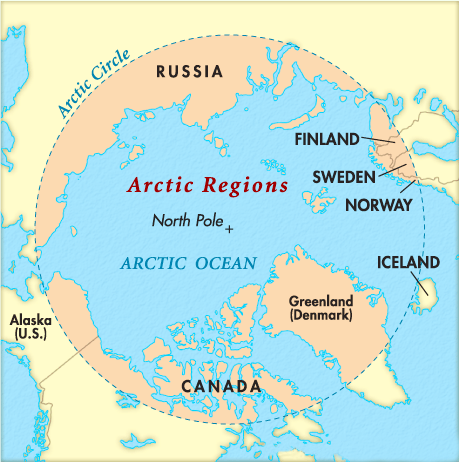Third Arctic Science Ministerial | 10 May 2021
Why in News
Recently, India participated in the 3rd Arctic Science Ministerial (ASM) and shared plans for research and long-term cooperation in the Arctic Region.
- The first two meetings—ASM1 and ASM2—were held in the USA in 2016 and Germany in 2018, respectively.
Arctic Region
- The Arctic region comprises the Arctic Ocean and parts of countries such as Canada, Denmark (Greenland), Norway, Russia, USA (Alaska), Finland, Sweden and Iceland.
- These countries together form the core of the Arctic Council, an intergovernmental forum.
- HQ: Norway
Key Points
- Third Arctic Science Ministerial Conference:
- Host Countries: It was jointly organised by Iceland and Japan.
- It was the first Ministerial meeting being held in Asia (Tokyo in Japan).
- Objective: It provides opportunities to various stakeholders, including academia, indigenous communities, governments and policymakers, to enhance collective understanding of the Arctic region, emphasize and engage in constant monitoring, and strengthen observations.
- Theme: ‘Knowledge for a Sustainable Arctic’.
- Host Countries: It was jointly organised by Iceland and Japan.
- India’s Stand:
- To contribute observing systems in the Arctic, both in-situ and by remote sensing.
- Would deploy open ocean mooring in the Arctic for long-term monitoring of upper ocean variables and marine meteorological parameters.
- The launch of NISAR (NASA-ISRO Synthetic Aperture Radar) satellite mission, in collaboration with the USA, is underway.
- Contributions to the Sustained Arctic Observational Network (SAON) would continue.
NASA-ISRO Synthetic Aperture Radar
- NISAR will scan the globe every 12 days over the course of its three-year mission of imaging the Earth’s land, ice sheets and sea ice to give an unprecedented view of the planet.
- It aims to conduct global measurements of the cause and consequences of land surface changes using advanced radar imaging.
Sustaining Arctic Observing Network
- It is a joint activity of the International Arctic Science Committee (IASC) and the Arctic Council.
- IASC is a non-governmental, international scientific organization.
- The purpose is to support and strengthen the development of multinational engagement for sustained and coordinated pan-Arctic observing and data sharing systems.
- India’s Engagement in the Arctic:
- India’s engagement with the Arctic dates back to 1920 with the signing of the Svalbard Treaty in Paris.
- Since July 2008, India has had a permanent research station in the Arctic called Himadri at NyAlesund, Svalbard Area in Norway.
- India received the ‘Observer’ country status in the Arctic Council in 2013 and is one among the 13 countries across the world, including China, to have that position which was again renewed in 2018.
- It has also deployed a multi-sensor moored observatory called IndARC in the Kongsfjorden fjord since July 2014.
- The research in the Arctic region from India is coordinated, conducted, and promoted by the National Centre for Polar and Ocean Research (NCPOR), Goa, under the Ministry of Earth Sciences, Government of India.
- Recently, India drafted a new Arctic policy that aims at expanding scientific research, sustainable tourism and exploration of mineral oil and gas in the Arctic region.
- Significance of Arctic Study for India:
- Though none of India’s territory directly falls in the Arctic region, it is a crucial area as the Arctic influences atmospheric, oceanographic and biogeochemical cycles of the earth’s ecosystem.
- Arctic warming and its ice melt are global concerns as they play a pivotal role in regulating climate, sea levels, and maintaining biodiversity.
- There is growing evidence of connection between the Arctic and the Indian Ocean (which modulates the Indian monsoon). Hence, improving the understanding of physical processes and quantifying the impact of Arctic ice melt on the Indian summer monsoon is very important.

